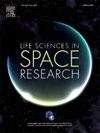Zebrafish selection strategy for the first zebrafish cultivation experiment on the Chinese space station
IF 2.8
3区 生物学
Q2 ASTRONOMY & ASTROPHYSICS
引用次数: 0
Abstract
With the continuous advancement of space exploration activities, the development of Biological Life Support Systems (BLSS) has become crucial for supporting long-duration space missions. This paper focuses on preparation process for the multifunctional closed aquatic ecosystem (CAES) experiment based on Ceratophyllum, zebrafish, and microorganisms, conducted in the Life and Ecological Science Experiment Cabinet of the Chinese Space Station. Given the complexity and high difficulty of the experimental objectives, the selection of zebrafish individuals is critical. Prior to the experiment, the selection process considered factors such as the adaptability of zebrafish in confined spaces, social compatibility, and physiological status. A set of screening criteria was established based on preliminary experiments with 120 zebrafish, analyzing aspects like anxiety behavior, response speed, swimming posture, and shoaling behavior. Finally, based on these screening criteria, four zebrafish were selected from the pre-screened pool before the space experiment. These four zebrafish successfully survived for 43 days in the space environment and completed the predetermined scientific objectives.
中国空间站首次斑马鱼养殖实验的斑马鱼选择策略
随着空间探索活动的不断推进,生物生命保障系统(BLSS)的发展已成为支持长时间空间任务的关键。本文主要研究了在中国空间站生命与生态科学实验柜中开展的角藻、斑马鱼和微生物多功能封闭水生生态系统(CAES)实验的制备过程。鉴于实验目标的复杂性和高难度,斑马鱼个体的选择至关重要。在实验之前,选择过程考虑了斑马鱼对密闭空间的适应性、社会相容性和生理状态等因素。通过对120尾斑马鱼的初步实验,从焦虑行为、反应速度、游泳姿势、浅滩行为等方面进行分析,建立了一套筛选标准。最后,根据这些筛选标准,在空间实验前从预筛选池中选择4条斑马鱼。这4条斑马鱼在太空环境中成功生存了43天,完成了预定的科学目标。
本文章由计算机程序翻译,如有差异,请以英文原文为准。
求助全文
约1分钟内获得全文
求助全文
来源期刊

Life Sciences in Space Research
Agricultural and Biological Sciences-Agricultural and Biological Sciences (miscellaneous)
CiteScore
5.30
自引率
8.00%
发文量
69
期刊介绍:
Life Sciences in Space Research publishes high quality original research and review articles in areas previously covered by the Life Sciences section of COSPAR''s other society journal Advances in Space Research.
Life Sciences in Space Research features an editorial team of top scientists in the space radiation field and guarantees a fast turnaround time from submission to editorial decision.
 求助内容:
求助内容: 应助结果提醒方式:
应助结果提醒方式:


